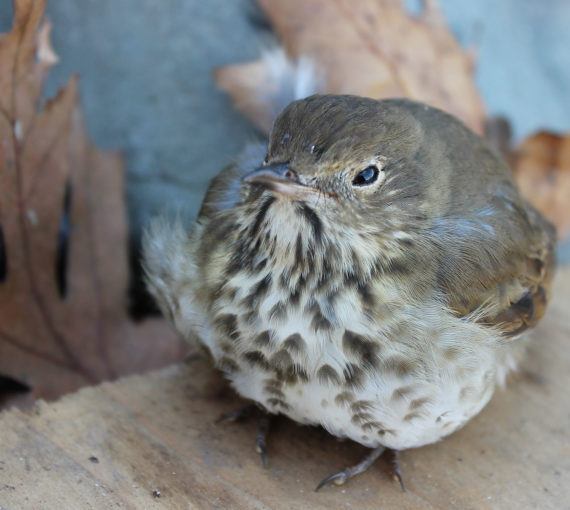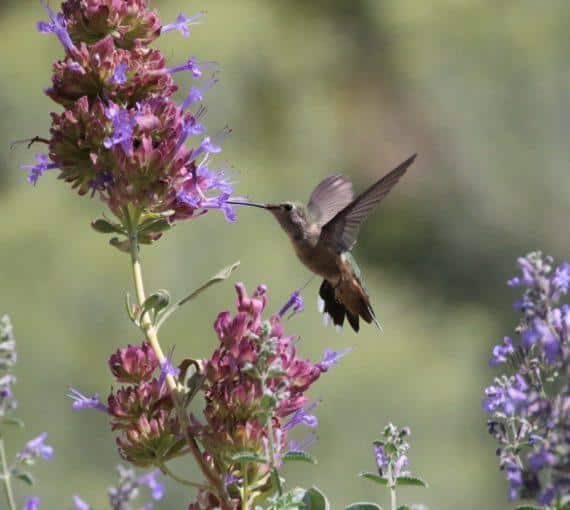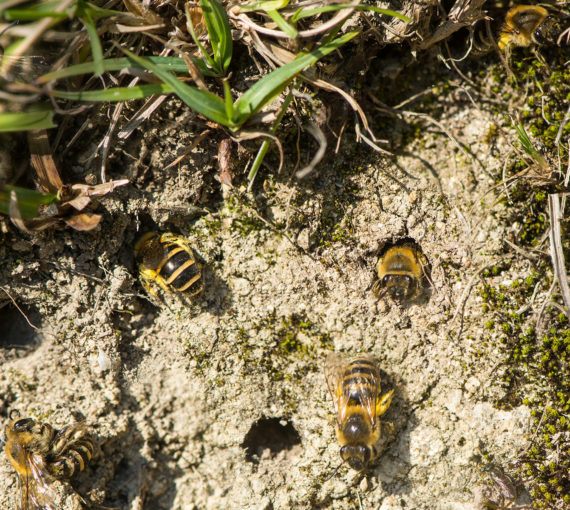
Bird feeders are popular for offering supplemental food to local bird populations. But without proper maintenance and care, they can do more harm than good. (Photo: Karen via Pexels)
Birds are vital to ecosystems. They pollinate plants, keep “pests” in check and disperse seeds. Human health and wellbeing are also boosted from hearing birdsong and watching their complex behaviours.
Supporting local bird populations by providing food and habitat benefits the environment, local community and people’s lives.
If birds ever become a nuisance, there are also friendly ways to deter them.
The healing benefits of birds
A 2022 study showed a “significant positive association between seeing or hearing birds and improved mental well-being, even when accounting for other possible explanations such as education, occupation, or the presence of greenery.” Natural stimuli, such as birdsong, can even help alleviate mental fatigue associated with living in stressful urban environments. Birds typically sing and make noise when there are no threats from predators. Humans have evolved to interpret bird song with safety. We find it relaxing.
Morning birdsong prompts cognitive activity. That waking alertness can reduce tiredness and make you more focused and productive throughout the day.
The special thing about birdsongs is that even if people live in very urban environments and do not have a lot of contact with nature, they link the songs of birds to vital and intact natural environments
Emil Stobbe, Centre for Environmental Neuroscience, Max Planck Institute for Human Development
Birdwatching also helps us feel more connected to nature and more aware of its interdependent relationships, enhancing our sense of responsibility to respect, protect and restore it.
Bird population health in Canada
Birds are sensitive to environmental changes. In Canada, habitat loss, pesticides and contaminants, pollution and invasive species are among the main threats to birds. A 2019 study tracked a cumulative loss of nearly three billion birds in North America since 1970. Forest degradation is one of the leading causes of bird population decreases throughout the country.
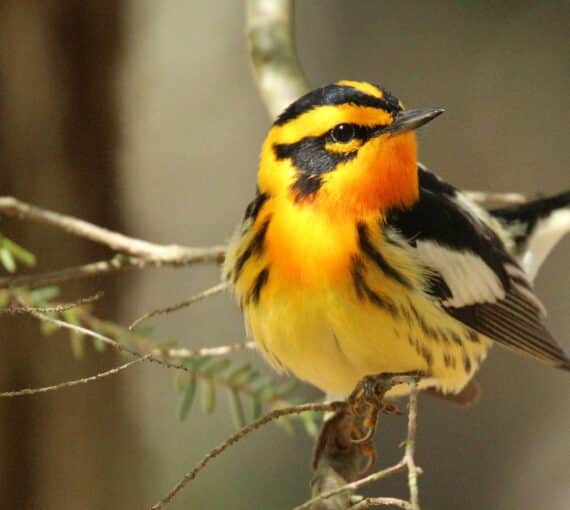
Forest degradation and bird population decline in Canada
Birds are indicators of forest health. One species or another occupies almost every niche in dynamic forest ecosystems throughout Canada. Their diminishing numbers indicate that our forests are being degraded.
Get to know local birds
Research which birds are likely to frequent your area. Apps like the Cornell Lab of Ornithology Merlin Bird ID can help you identify them. Check out thrift stores for second-hand local bird guides or search online. Lean on your community for support and knowledge exchange opportunities. Join a local birding group.
How to grow a bird-friendly garden that provides food and habitat
Welcome local birds by growing nesting materials and food. To help maximize your impact for birds specific to your area, find out what bird garden zone you’re in!
Birds eat a variety of foods and their diets change with age. For example, during their life cycle, 96 per cent of terrestrial North American bird species rely on insects for some part of their diet. Garden to attract native, beneficial insects like caterpillars (main food source for baby songbirds!), beetles and snails.
Growing a bird-friendly garden is a great way to start rewilding your green space or take it a step further!
Examples of native flowering plants good for nest-building materials and/or food:
- Purple coneflowers a.k.a. Echinacea (Echinacea purpurea). The blooms attract butterflies, birds and other pollinators during summer and provide seeds for many bird species in fall. Plant this wildflower to support American goldfinches, black-capped chickadees, downy woodpeckers and others.
- Sunflowers (Helianthus). Iconic sunflower seeds are a great source of fuel for many migratory birds’ long journeys. Plant sunflowers to support pine siskins, purple finches, rose-breasted grosbeaks and others.
- Cardinal flower (Lobelia cardinalis). The bright red tubular flowers attract hummingbirds who feed on their nectar.
- Milkweed (Asclepias). Though best known for hosting monarch butterfly caterpillars, American goldfinches, Baltimore orioles and black-capped chickadees and other bird species use the fibre and downy part of the seeds as nesting material.
- Velvet-leaved blueberry (Vaccinium myrtilloides). A delicious native edible perennial favoured by caterpillars like the northern azure. Bluebirds, flycatchers, orioles, woodpeckers and warblers are just a few that feed on caterpillars and blueberries.
Examples of native shrubs good for nest-building materials, habitat and/or food:
- Arrowwood (Viburnum dentatum). Many species of birds, including American robins, grey catbirds and northern mockingbirds, use this shrub to nest in or as cover.
- Chokeberry (Aronia melanocarpa). Birds eat the berries in winter after more desirable fruit has been depleted.
- Serviceberry (Amelanchier canadensis). Great for nesting materials, nesting sites and a convenient food source (once berries ripen).
Bonus! Many of these plants are edible perennials for humans too.
Caution: If you prune trees and shrubs in spring, watch for tiny nests (e.g., hummingbirds). Learn what to do if you find a downed nest (e.g., after a storm event), nestling or fledgling on the ground.
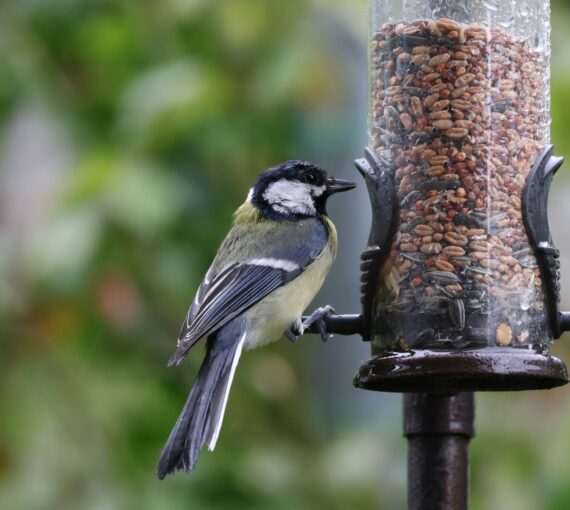
Learn local bird feeding bylaws
Consult local bylaws before setting up any feeders. Most municipalities permit feeding hummingbirds and other birds on private property but may stipulate that feeders be kept clean and inaccessible to other wildlife.
Never feed ducks, geese, pigeons, seagulls, crows or other birds in public areas.
How to feed birds
Growing a bird-friendly garden is the best way to provide food and habitat for local birds. But it’s not an accessible option for everyone.
Bird feeders are popular for offering supplemental food to local bird populations. But without proper maintenance and care, they can do more harm than good.
Hummingbird feeders
Native flowering plants are the ideal food source for hummingbirds. You may wish to supplement during nesting season and migration (spring to late fall) with a well-maintained sugar-water feeder.
To avoid unintentional harm:
- Choose a safe spot. Hummingbirds prefer feeders in cool areas, protected from wind and direct sun where the nectar solution will spoil quickly. Hang feeders near shrubs and trees. Popular window feeders can increase the likelihood of window collisions. Place feeders one metre away from windows.
- Only use refined white sugar. Never use brown sugar, honey, powdered sugar, corn syrup, molasses, artificial sweeteners or raw, unprocessed sugars for nectar solution. These may contain ingredients harmful to hummingbirds.
- Never add red food colouring to the nectar solution. Hummingbirds are attracted to red, but red dye in feeders can hurt the birds.
- Empty and clean regularly. Empty and clean your feeder twice a week in hot weather and once a week when it’s cooler. Use regular tap water or a diluted vinegar solution. Avoid using dish soaps, which can leave a harmful residue.
Hummingbird nectar solution recipe
In a pot, combine:
- 60 ml (¼ cup) sugar
- 250 ml (1 cup) water
Bring to a boil until sugar is fully dissolved. Cool and fill feeder.
Bird feeders
Feeders are an excellent way to attract an array of local birds. They provide supplemental food, especially when natural supplies are scarce, such as in winter or during droughts. Birds expend tremendous energy during migratory seasons. Feeders offer much-needed spots to rest and refuel.
Though they’re one of the most accessible ways to support local birds, don’t make feeders the focus of your bird support. To truly support wildlife, focus on habitat over homes.
Four common types of bird feeders:
- Ground feeders. These screen-bottomed platform feeders typically sit a few inches off the ground or deck. Some have covers to keep out snow or wire mesh to discourage squirrels and other rodents. Place the feeder at least three metres from a tree or shrub so birds can flee predators. Great for ground foragers such as American goldfinches, dark-eyed juncos and fox, song and white-crowned sparrows.
- Sunflower seed tube feeders. Choose a model with metal ports around the seed dispensers to deter squirrels. Hang at least 1 ½ metres off the ground. Great for black-capped and boreal chickadees, purple finches and red-breasted nuthatches.
- Suet cage feeders. Suet, made of rendered animal fat (e.g., cow or mutton), flour, grains, seed and/or nut butter, is high in calories. It’s a great supplement during cooler months when natural food is scarce. Buy a feeder and suet or make your own — see the recipe below!
- Hopper feeders. Birds hopping on the feeder trigger the release of seeds — great for keeping larger amounts of feed dry. Hang on a pole about 1 ½ metres off the ground or from a tree branch. Helps many smaller birds, plus larger ones such as brown-headed cowbirds, red-winged blackbirds and Canada and Stellar’s jays.
To avoid unintentional harm:
- Choose a safe spot. Prevent window strikes, collisions, injuries, predation and conflicts with other wildlife. Place feeders at least one metre away from windows, in a protected area away from wind, rain and snow. Apply decals or tape on nearby windows.
- Keeps feeders clean. Clean them every two or so weeks. Clean more frequently after periods of high use, disease outbreaks and/or wet weather. Take feeder apart. Handwash with boiling water and soap. Rinse thoroughly. Let dry completely before refilling.
- Stay aware of local bird disease outbreaks. Bird feeders can be hot spots for spreading diseases like salmonella, conjunctivitis and avian influenza. Remove bird feeders during risk periods. Consult your local SPCA for advice.
- Clean the ground below feeders. Regularly remove uneaten seeds, hulls and other waste. Rodents and other wildlife will be attracted to spilled feed. Buildups can also result in mouldy or spoiled food harmful to pets, birds and other wildlife.
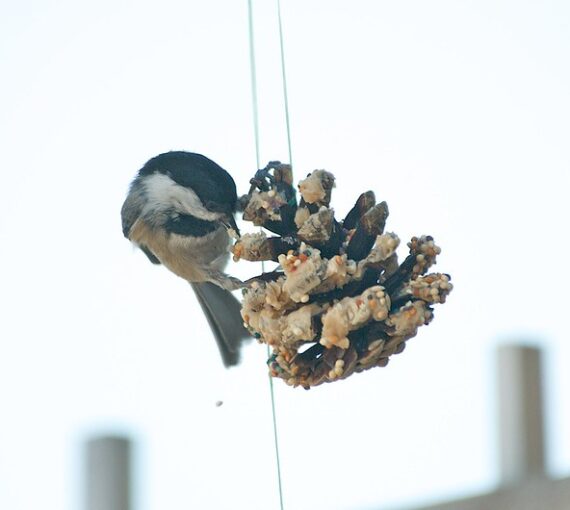
Make your own suet “fat block” bird feeder!
Whether they’re fall migrants or year-long residents, supplementing bird diets with high-quality calories will help them survive to reproduce in spring.
Ingredients:
- 250 ml (1 cup) crunchy peanut, nut or seed butter (no fillers or additives)
- 250 ml (1 cup) whole wheat or white flour
- 250 ml (1 cup) suet and/or coconut oil
- 950 ml (4 cups) grains, seeds, legumes and/or dried fruit*
Use local, organic ingredients if you can.
*More options: rolled oats, cracked corn, cornmeal, black oiled sunflower seeds, striped sunflower seeds, shelled sunflower seeds, millet, raw/unsalted peanuts, currants, cranberries, raisins, apples, wild berries or pre-mixed bird seed. (Note: Many birds won’t be able to eat seeds in the shell once they’re coated in fat. You may have to substitute unshelled seeds.)
Directions:
- Melt fat in a saucepan on low heat.
- Mix other ingredients together in a large bowl.
- Pour melted fat over dry mixture, stir well and pour into pancake, loaf or muffin tins — all work well.
- If you’re using a larger pan, cut the mixture into smaller blocks or cakes once it’s cooled.
- Spread one serving of feeder mixture onto tree bark or a pinecone. Or place one fat block into a clean metal suet cage feeder.
Tips!
- Buy suet from a butcher or wild bird store. If using vegetable fat, be sure it’s non-hydrogenated — better for birds for the same reasons it’s better for humans.
- To avoid attracting rats, squirrels and raccoons, suet feed blocks should be small enough for birds to consume in a day. Discard rancid or mouldy feeders. Blocks can be frozen until needed.
- To hang your feeder from a tree branch, secure the holder to a tree trunk with wire or string. Keep it at a distance from birdhouses or nest boxes to avoid attracting predators.
- Don’t use mesh bags to hang a suet block. They can trap birds’ feet and beaks, causing injury — even death.
How to create a birdbath
The worsening climate crisis has contributed to increasing water scarcity and prolonged periods of drought. That impacts everyone and everything, including wildlife.
A water source in your bird-friendly yard or garden encourages and supports bird visitors. Bonus: It also provides cooling respite during warmer months and heat waves.
Birdbaths are the most common, affordable way to provide water. Choose from many types — pedestal, ground, heated, mounted, hanging. You can even make your own!
To avoid unintentional harm:
- Reject birdbaths containing lead, zinc and/or copper. Some metals are toxic to birds. Avoid glazed ceramic unless the glaze is lead-free. Opt for cast aluminum, cast iron, tempered glass or granite.
- Keep your birdbath clean and fresh. Replace water every other day to prevent algae, grime buildup and disease transmission. Stagnant water attracts mosquitoes! Clean between refreshes with a solution made of one part white vinegar, nine parts water.
- Place away from woody brush and bird feeders. Falling debris and seeds can dirty the water quickly.
How to provide bird nesting material
Attract and support birds by offering nesting material! It’s a great way to complement other rewilding efforts like pollinator-friendly gardening and planting a butterfly garden.
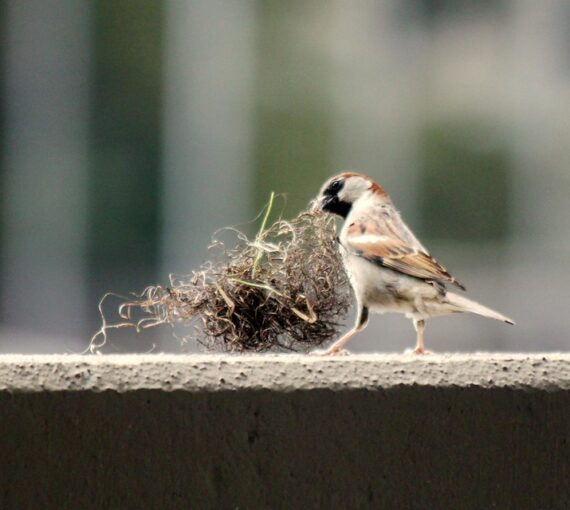
Step 1: Collect
Collect natural, biodegradable, pesticide-free nesting materials:
- Dog fur and/or cat hair (free from flea and tick treatment chemicals and shampoos), horsehair (from grooming brushes) or wool.
- Moss.
- Dry grass.
- Cattail fluff.
- Leaves, twigs and strips of bark.
- Dried leaves.
Never offer:
- Human hair. It’s too thin and can cut or tangle birds.
- Yarn or string.
- Dryer lint. It can be full of chemicals and plastic microfibres.
- Synthetic fibres.
- Tinsel, aluminum foil or cellophane.
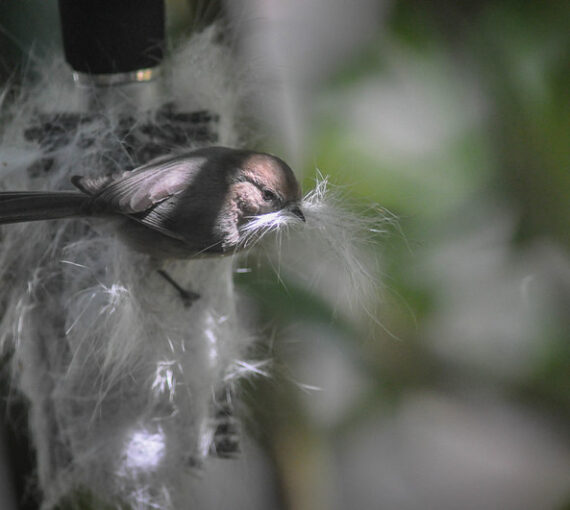
Step 2: Combine and display
Offer and display the nesting material, preferably in a spot sheltered from rain:
- Create a pile on the ground (e.g., leaves, twigs and strips of bark).
- Stuff in tree crevices.
- Drape over vegetation.
- Place or hang in paper, straw or wood berry baskets.
- Fill your cleaned metal suet feeder from winter.
- Hang a DIY wire holder (such as the head of a repurposed kitchen whisk).

Step 3: Replenish
Replenish as needed from March to approximately July.
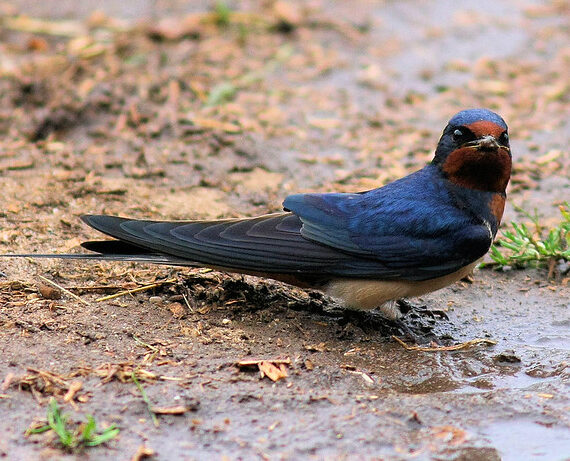
Tips!
- Buy bird-nesting material at most wild bird stores or where bird seed is sold. Most contain cotton, hemp and wool fibres or fluff.
- Swallows and robins also use mud. Keep a patch of bare ground and exposed soil available. Native mason bees and butterflies also need exposed soil and mud puddles.
Solutions to common bird problems for homeowners
Birds are vital to ecosystems. But their behaviour can be a nuisance to humans—even lead to conflicts. The good news? You can prevent risks to them and you by identifying and deterring specific bird behaviours.
Nesting
To protect themselves and their offspring from predators in more forested areas, birds often nest near or around houses and buildings.
If a bird is nesting near your home, minimize disturbances. Keep a respectful distance, minimize foot traffic and postpone planned projects or construction for that area. The good news? Most songbirds (e.g., robins, warblers, ravens, crows, finches, etc.) nest for about a month. To ensure the parents won’t abandon their nest, leave it alone and minimize disturbance around it until the young have fledged.
If you try to relocate the nest, birds will often abandon it. Consider moving it only in the most extreme circumstances. If you must move a nest, keep it within half a metre of the original location. Monitor the new location closely to ensure the parents return. If they don’t, contact a local wildlife rehabilitator for advice.
How to identify nesting sites:
- Regularly inspect areas under eaves, porches, patios and sheltered spots where birds might build nests.
- Look for droppings, nesting materials (twigs, grass, feathers, etc.) and increased bird activity in specific areas.
- Listen for bird chatter.
Want to keep birds away? Try these humane, non-lethal, eco-friendly strategies:
- Block access. Install bird netting or mesh over likely areas, such as vents, chimneys and eaves. Use humane bird spikes on sloped surfaces to make potential nesting spots less appealing.
- Use sound. Discourage nesting by using sound-based deterrents like wind chimes. Bonus: they add a lovely ambiance!
- Use scents. Birds don’t like certain smells, like citrus. Add a few drops of lemon essential oil to a spray bottle of water. Spray on your porch, patio and any attractive nesting spots.
- Use sight. Birds don’t like shiny objects, especially ones that move. Cut aluminum foil into strips and hang it on your porch or patio. Or hang old CDs on a string.
Digging and nibbling
A physical barrier is the best way to stop birds from nibbling on your garden. Use netting or wire cloches around fruit trees, berry bushes and other plants birds like to eat. Try planting bird-repelling flowers and herbs such as rosemary, lavender and chamomile. Both methods will also help prevent birds from digging up flowerpots and soil when hunting for worms and grubs, harming other plants in the process.
Pecking
Male woodpeckers often pound on hard, loud and resonating objects outside a home (e.g., chimneys, gutters, eaves, window shutters, etc.) during the morning. This territorial behaviour occurs mostly during courtship and nesting seasons. To deter them, drape plastic or aluminum foil over the area.
If a woodpecker is damaging walls and siding, it’s often because there are insects in the wood (e.g., carpenter bees, ants, termites, etc.). To prevent this, remove the food source.

Help bird conservation through community science opportunities!
A community science project can involve one person or millions collaborating on a common goal. As a participant, you’ll help us all gain a better understanding of the world and our place in it.
For example, Project NestWatch is a program that monitors breeding birds and nesting activity in Canada long term.
Look for local birding groups or community science opportunities. They’re great ways to protect nature and build community!

Help make cities safe for birds
Future Ground Network member group Never Collide is a community-led movement to save birds in cities. It aims to educate public and corporate leaders about severely declining bird populations and encourage them to help prevent window collisions.
Want to help birds where you live?

